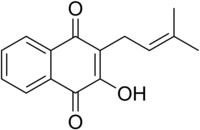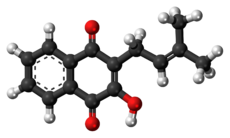Lapachol

| |

| |
| Names | |
|---|---|
| Preferred IUPAC name
2-Hydroxy-3-(3-methylbut-2-en-1-yl)naphthalene-1,4-dione | |
| Identifiers | |
3D model (
JSmol ) |
|
| ChEBI | |
| ChEMBL | |
| ChemSpider | |
ECHA InfoCard
|
100.001.421 |
| EC Number |
|
PubChem CID
|
|
| UNII | |
CompTox Dashboard (EPA)
|
|
| |
| |
| Properties | |
| C15H14O3 | |
| Molar mass | 242.27 |
| Appearance | Yellow crystals |
| Melting point | 140 °C (284 °F; 413 K) |
Except where otherwise noted, data are given for materials in their standard state (at 25 °C [77 °F], 100 kPa).
| |
Lapachol is a
known botanically as Handroanthus impetiginosus, but was formerly known by various other botanical names such as Tabebuia avellanedae.[4]
Lapachol is also found in other species of Handroanthus.
Lapachol is usually encountered as a yellow, skin-irritating powder from wood. Chemically, it is a derivative of vitamin K.[5]
Once studied as a possible treatment for some types of cancer, it is now considered too toxic for use.[6][7][8][9]
See also
References
- ^ [1] Lapochol at R&D Chemicals.
- ^ "ChromaDex Incorporated General Product Information for LAPACHOL(RG)". Archived from the original on 2007-09-28. Retrieved 2007-07-06. Lapochol at CromaDex.
- ^ Record, Samuel J.. "Lapachol" pages 17-19. In: Tropical Woods (1925).
- S2CID 8824926.
- ^ Louis F.Fieser. The Scientific Method pages 163-191. Reinhold Publishing Corporation, New York, 1964
- PMID 12413627.
- ^ Oral toxicology studies with lapachol. Morrison, Robert K.; Brown, Donald Emerson; Oleson, Jerome J.; Cooney, David A. Toxicology and Applied Pharmacology (1970), 17(1), 1-11.
- PMID 11340475.
- PMID 17421057.
